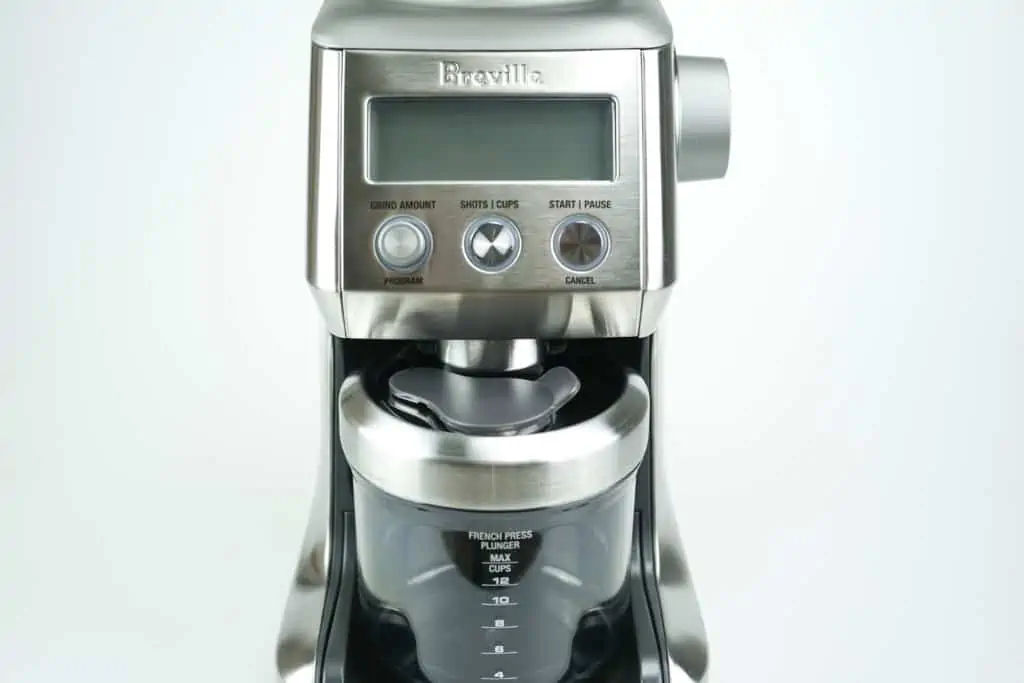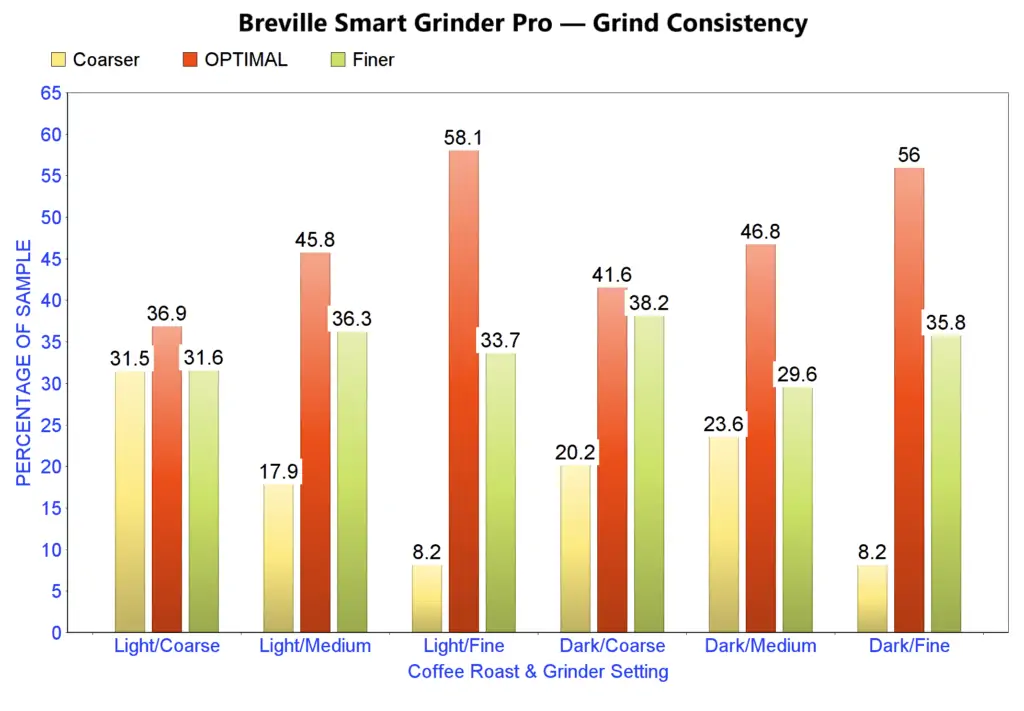
Overall Rating: 9.0
Pros: The Smart Grinder Pro’s grind consistency is best among the four grinders we review for this report. It is also relatively quiet, and its capacity for supporting espresso brewing is particularly impressive for a machine offered at so reasonable a price.
Cons: The stubbornly convoluted user interface takes either patience or a workaround to overcome.
MSRP: $199.95
How to Interpret Equipment Ratings | Read complete report: Four Mid-Range Burr Coffee Grinders Tested & Reviewed
Reviewer’s Take:
Excellent performance and many clever details contribute to the brainy design of the Breville Smart Grinder Pro, although there are moments when the device might just be a little too smart for its own good.
User Interface. The digital LCD screen is helpful for choosing and returning to one of the Breville’s generous 60 grind adjustments (many of which are fine enough for espresso brewing). Beans feed smoothly, and the burrs stop promptly enough so that setting the timer results in a reliably consistent dose. Yet Breville, ever the hand-holder when it comes to all things coffee, also baked in a prescribed time-per-cup dosing system that is both confusing and persistent.
The machine encourages you to grind by the number of cups or shots you intend to brew, which is useful if you agree with Breville on how much ground coffee is best per cup or shot. Press the center button on the interface to add a serving and the machine sets a corresponding grind-time. But if you enjoy a variety of coffees at different roast levels brewed different ways, the stubborn persistence of this system becomes a nuisance in a hurry.
You can change the time setting by increments of 0.2 seconds, but using these impressively fine increments are tedious when you are trying to move the timer forward or back a few whole seconds at a time. It’s also possible to reprogram individual cup settings, though that may not be worth the effort given how the many differences from one coffee to the next, including time off the roast, affect grind requirements.
Breville seems to go out of its way here to try to accommodate neophytes, which is a quality some will appreciate and others, like us, can still work around. We opted out of the befuddlement by always setting the timer to grind more than we needed and simply starting and stopping the grind action manually. This strategy freed us to enjoy the otherwise outstanding grind consistency and quiet operation of Breville’s impressively versatile and well-engineered hardware.
Noise and Static. With the Breville’s generous hopper full and a medium grind setting, our decibel meter registered an amazingly low 80dB during grinding, which is a full 15dB quieter than other machines we reviewed for this report. Under somewhat different conditions this rose to an average 85dB and a wavering, higher-pitch whine emerged in the espresso range, but in general the machine remains easier on the ears than most, and provides comfort in knowing the racket most likely won’t disturb a napping toddler while you prepare that critical afternoon cup.
The machine also mitigates static well enough to allow the user to run the machine without using the problematic lid that fits atop its wide-mouthed catch cup. Vibration during longer grinds causes the cup to shift out of place beneath the chute, resulting in misalignment of the opening of the lid beneath the flow of grounds. Coffee then piles up on the closed portion of the lid, potentially high enough to cause the grinder to fail due to clogging, which it did once in our tests. Skipping that lid altogether and stowing it in a drawer solved the problem.
Particle-Size Uniformity and Grounds Retention. Laser diffraction particle size analysis performed by our friends at Horiba Instruments confirmed that of the four grinders we tested for this report, the Smart Grinder Pro, at a variety of settings, generates the highest percentage of grounds within an optimal range of particle size. Its best performance was at a fine grind of a light roast, where it landed 58.1% inside a range of 400 microns. That may not sound like much, but it’s the best we saw among the four well-respected grinders we tested for this report. For detailed test results see the bar graph at the end of this review.
Yet of the relatively few fine particles Smart Grinder Pro does create, plenty have a tendency to stick around. Cleaning out the grinder revealed roughly 3 grams of retained grounds, the majority of which was very fine powder caked beneath the cone burr at the bottom of the chamber. This isn’t the worst grounds retention we’ve seen, but it’s also not the best.
The Bottom Line. There’s much more to like than dislike about this squat and clever machine that grinds more consistently at $25-$70 cheaper than any of the other three grinders reviewed in this report. The Breville brand’s rounded and contoured design language may not blend with every kitchen aesthetic, but for the relatively low price you would be hard pressed to find a machine as all-around ready to contribute to any morning coffee ritual.
Key Specifications:
Hopper Capacity: 18 ounces
Dimensions: 6.3″ x 8.5″ x 15.5″
Weight: 6.4 pounds
Burrs: 40mm stainless steel conical
Burr Speed: 450 RPM
Grind Settings: 60
MSRP: $199.95
Manufacturer’s Website: www.breville.com
 Grind consistency test results for the Breville Smart Grinder Pro based on laser particle size distribution analysis by Horiba Instruments. Six samples were tested from each grinder representing various grind settings (coarse, medium, fine) and two degrees of roast (light and medium-dark). Like other grinders we tested, the Breville was at its best producing fine grinds. For an explanation of how we determined our optimal range of particle sizes click here.
Grind consistency test results for the Breville Smart Grinder Pro based on laser particle size distribution analysis by Horiba Instruments. Six samples were tested from each grinder representing various grind settings (coarse, medium, fine) and two degrees of roast (light and medium-dark). Like other grinders we tested, the Breville was at its best producing fine grinds. For an explanation of how we determined our optimal range of particle sizes click here.










